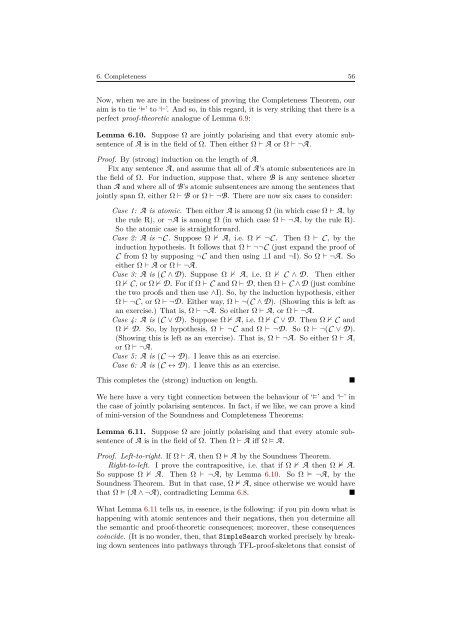Metatheory - University of Cambridge
Metatheory - University of Cambridge
Metatheory - University of Cambridge
Create successful ePaper yourself
Turn your PDF publications into a flip-book with our unique Google optimized e-Paper software.
6. Completeness 56<br />
Now, when we are in the business <strong>of</strong> proving the Completeness Theorem, our<br />
aim is to tie ‘⊨’ to ‘⊢’. And so, in this regard, it is very striking that there is a<br />
perfect pro<strong>of</strong>-theoretic analogue <strong>of</strong> Lemma 6.9:<br />
Lemma 6.10. Suppose Ω are jointly polarising and that every atomic subsentence<br />
<strong>of</strong> A is in the field <strong>of</strong> Ω. Then either Ω ⊢ A or Ω ⊢ ¬A.<br />
Pro<strong>of</strong>. By (strong) induction on the length <strong>of</strong> A.<br />
Fix any sentence A, and assume that all <strong>of</strong> A’s atomic subsentences are in<br />
the field <strong>of</strong> Ω. For induction, suppose that, where B is any sentence shorter<br />
than A and where all <strong>of</strong> B’s atomic subsentences are among the sentences that<br />
jointly span Ω, either Ω ⊢ B or Ω ⊢ ¬B. There are now six cases to consider:<br />
Case 1: A is atomic. Then either A is among Ω (in which case Ω ⊢ A, by<br />
the rule R), or ¬A is among Ω (in which case Ω ⊢ ¬A, by the rule R).<br />
So the atomic case is straightforward.<br />
Case 2: A is ¬C . Suppose Ω ⊬ A, i.e. Ω ⊬ ¬C . Then Ω ⊢ C , by the<br />
induction hypothesis. It follows that Ω ⊢ ¬¬C (just expand the pro<strong>of</strong> <strong>of</strong><br />
C from Ω by supposing ¬C and then using ⊥I and ¬I). So Ω ⊢ ¬A. So<br />
either Ω ⊢ A or Ω ⊢ ¬A.<br />
Case 3: A is (C ∧ D). Suppose Ω ⊬ A, i.e. Ω ⊬ C ∧ D. Then either<br />
Ω ⊬ C , or Ω ⊬ D. For if Ω ⊢ C and Ω ⊢ D, then Ω ⊢ C ∧D (just combine<br />
the two pro<strong>of</strong>s and then use ∧I). So, by the induction hypothesis, either<br />
Ω ⊢ ¬C , or Ω ⊢ ¬D. Either way, Ω ⊢ ¬(C ∧ D). (Showing this is left as<br />
an exercise.) That is, Ω ⊢ ¬A. So either Ω ⊢ A, or Ω ⊢ ¬A.<br />
Case 4: A is (C ∨ D). Suppose Ω ⊬ A, i.e. Ω ⊬ C ∨ D. Then Ω ⊬ C and<br />
Ω ⊬ D. So, by hypothesis, Ω ⊢ ¬C and Ω ⊢ ¬D. So Ω ⊢ ¬(C ∨ D).<br />
(Showing this is left as an exercise). That is, Ω ⊢ ¬A. So either Ω ⊢ A,<br />
or Ω ⊢ ¬A.<br />
Case 5: A is (C → D). I leave this as an exercise.<br />
Case 6: A is (C ↔ D). I leave this as an exercise.<br />
This completes the (strong) induction on length.<br />
■<br />
We here have a very tight connection between the behaviour <strong>of</strong> ‘⊨’ and ‘⊢’ in<br />
the case <strong>of</strong> jointly polarising sentences. In fact, if we like, we can prove a kind<br />
<strong>of</strong> mini-version <strong>of</strong> the Soundness and Completeness Theorems:<br />
Lemma 6.11. Suppose Ω are jointly polarising and that every atomic subsentence<br />
<strong>of</strong> A is in the field <strong>of</strong> Ω. Then Ω ⊢ A iff Ω ⊨ A.<br />
Pro<strong>of</strong>. Left-to-right. If Ω ⊢ A, then Ω ⊨ A by the Soundness Theorem.<br />
Right-to-left. I prove the contrapositive, i.e. that if Ω ⊬ A then Ω ⊭ A.<br />
So suppose Ω ⊬ A. Then Ω ⊢ ¬A, by Lemma 6.10. So Ω ⊨ ¬A, by the<br />
Soundness Theorem. But in that case, Ω ⊭ A, since otherwise we would have<br />
that Ω ⊨ (A ∧ ¬A), contradicting Lemma 6.8.<br />
■<br />
What Lemma 6.11 tells us, in essence, is the following: if you pin down what is<br />
happening with atomic sentences and their negations, then you determine all<br />
the semantic and pro<strong>of</strong>-theoretic consequences; moreover, these consequences<br />
coincide. (It is no wonder, then, that SimpleSearch worked precisely by breaking<br />
down sentences into pathways through TFL-pro<strong>of</strong>-skeletons that consist <strong>of</strong>
















